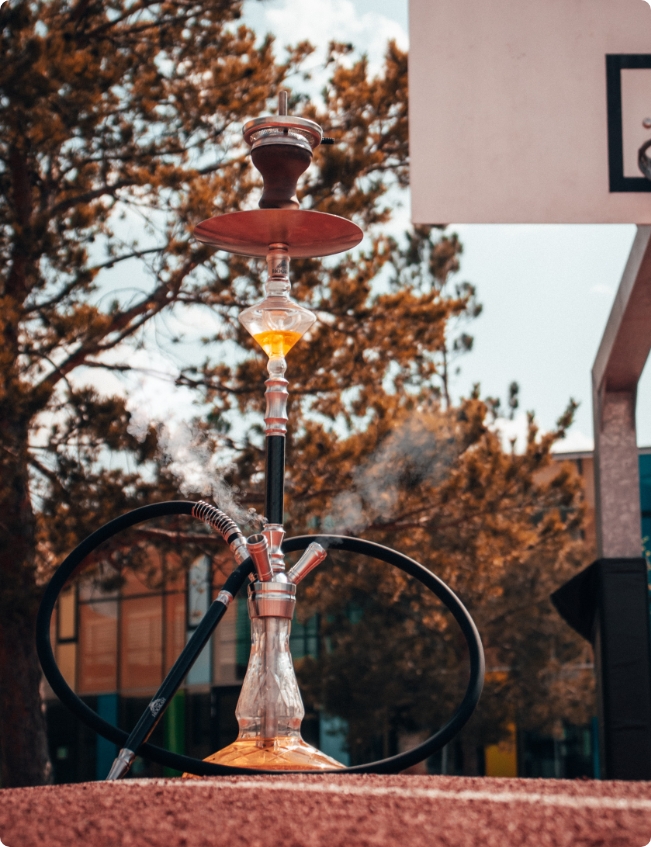
Waterpipe overview
History
In the late 19th century and the earlier part of the 20th century, waterpipe tobacco smoking was popular among older men in the Middle East who used primarily the harsh non-flavored referred to as Ajami tobacco. However, the introduction of flavored tobacco in the early 1990’s rapidly escalated the use among young people, starting in the Middle East and expanding to other countries and continents, through universities and schools. Today, WTS cafés are gaining in popularity around the world, including Britain, France, Russia, the Middle East, and the United States and its use by youth and college students is increasing. In many countries, waterpipe smoking is not monitored. However studies of the prevalence of waterpipe smoking in various populations showed high numbers, especially among young people.
There are numerous kinds of waterpipes around the world, referred to as: Hookah, Narghile or Narghila, Argileh, Shisha or Sheesha, Hubble-bubble or Hubbly-bubbly and Goza.
The origin of this smoking mode is somewhat unclear, but it is known that trade routes through India and China helped disseminate the practice throughout parts of Asia, the Middle East and Africa
According to one historical account, the waterpipe was invented in India by a physician during the reign of Emperor Akbar (who ruled from 1556 to 1605) as a purportedly less harmful method of tobacco use. The physician, Hakim Abul Fath, suggested that tobacco “smoke should be first passed through a small receptacle of water so that it would be rendered harmless.” A form of waterpipe used in India in the sixteenth century was made from a coconut shell as the water reservoir, with a bamboo reed inserted through the top. (From Tobacco Smoking using a Waterpipe: product, prevalence, chemistry/toxicology, pharmacological effects, and health hazards – A monograph prepared for The WHO Study Group on Tobacco Product Regulation (TobReg))

What is a waterpipe?
The Waterpipe Design And Components
There are regional and cultural differences in waterpipe design features, such as the size, shape, and style but it consist of four main parts.
- A head or tobacco bowl in which tobacco is placed and heated.
- A bod or pipe, which connects the tobacco bowl to the base liquid bowl.
- A base bowl filled with water or other liquids.
- A hose through which smoke is drawn.
- A mouthpiece.
The waterpipe is used to smoke tobacco by indirectly heating it, with burning charcoal. The smoke is filtered through a bowl of water and then drawn through a rubber hose to a mouthpiece.
Waterpipes are sometimes marketed as portable, with accessories such as carrying straps or cases. Some accessories are sold that are claimed to reduce the harmfulness of the smoke, such as mouthpieces containing activated charcoal or cotton, chemical additives to the water bowl and plastic mesh fittings to create smaller bubbles. None of these accessories has been tested empirically to verify whether they reduce smokers’ exposure to toxicants or diminish their risks for tobacco-caused disease and death.

The Waterpipe Tobacco Products
- Tobacco products are products made up of leaf tobacco as raw material, which are intended to be smoked, sucked, chewed or snuffed. All contain the highly addictive ingredient, nicotine.
- WP products are a heterogeneous group of products that vary widely in appearance and composition
- Tobacco can come in different flavors, such as and not exclusive to apple, mint, cherry, chocolate, coconut, licorice, cappuccino, and watermelon
- There are two major types of WPT one is separated from heated coal in the waterpipe by pierced aluminum foil: Mo’assel, and the traditional Ajami on which the coal is directly placed to burn.
- Ajami are unflavored waterpipe tobacco form or Tumbak, Tunbak or Jurak, which may have a higher tobacco ratio, and be in direct contact with the heated coal in waterpipe.
- Mo’assel or Mo’assal which means ‘honeyed’ and is made up of about one-third tobacco mixed with two-thirds honey and fruit flavors.
- Great variety of flavorings, including fruits (e.g. apple, grape, cherry, lemon, coconut, banana), herbs (e.g. mint) and flowers (e.g. rose) are used. Because of the flavorings and reduced harshness, Maasal is today the most widely used WP tobacco product

The Problem
The new tobacco use trend of the 21st century is “Waterpipe Tobacco Smoking” (WTS). Tobacco use is one of the main risk factors for chronic diseases such as cancer, lung infections, and cardiovascular diseases. Existing data on waterpipe smoking shows that it carries the same health risks caused by cigarette smoking.
The problem is the widespread misunderstandings that exist about its use and access to this form of tobacco use continues to grow, especially in cafes targeting teenagers and adults.
Reliable and good quality evidence in the literature, on the subject of cessation and waterpipe specific regulation which are important if we are to prevent and control waterpipe tobacco smoking globally is urgently needed. The WHO FCTC Waterpipe Tobacco Smoking Knowledge Hub aims to educate the public about the potential dangers of the growing waterpipe trend.
